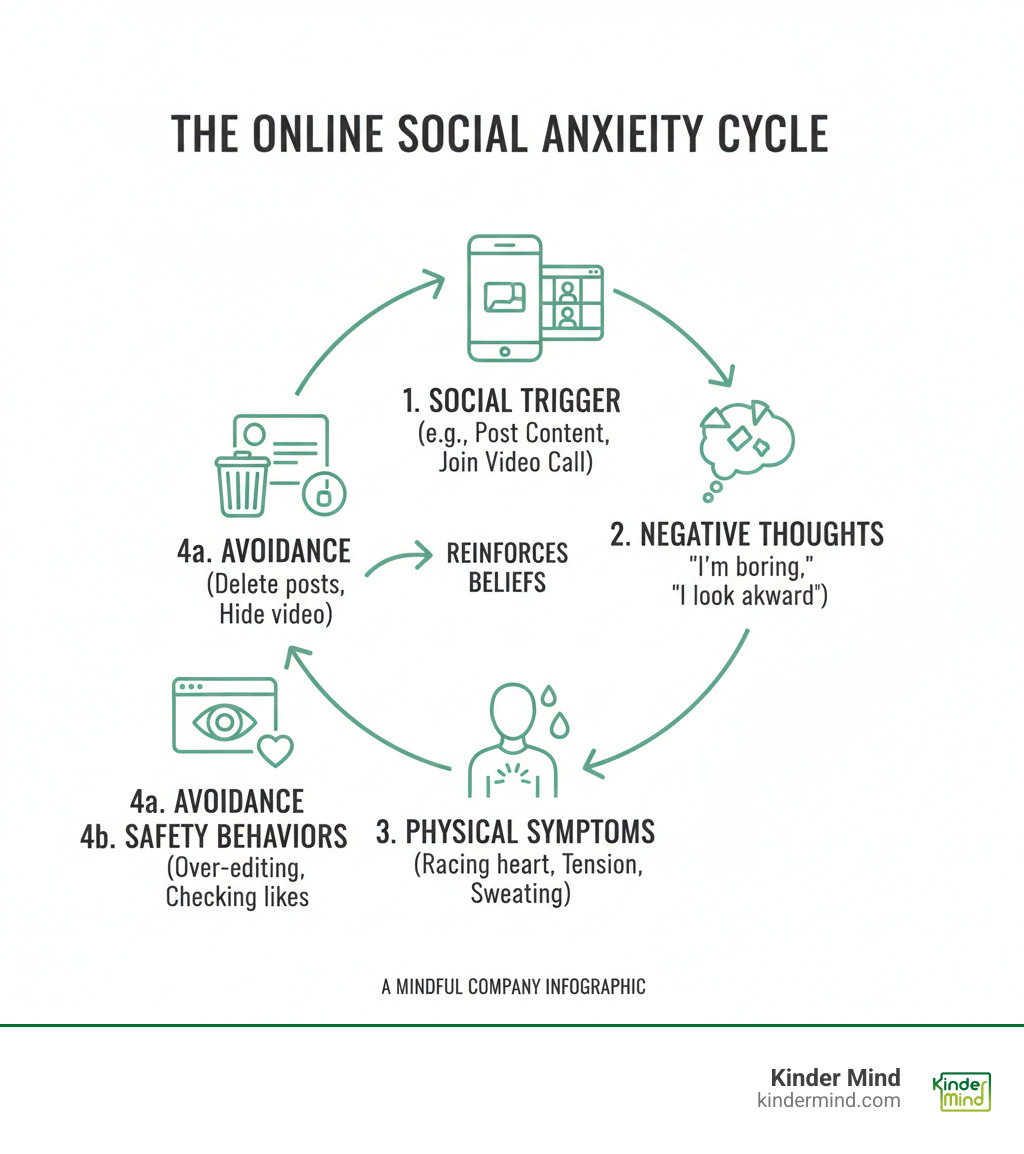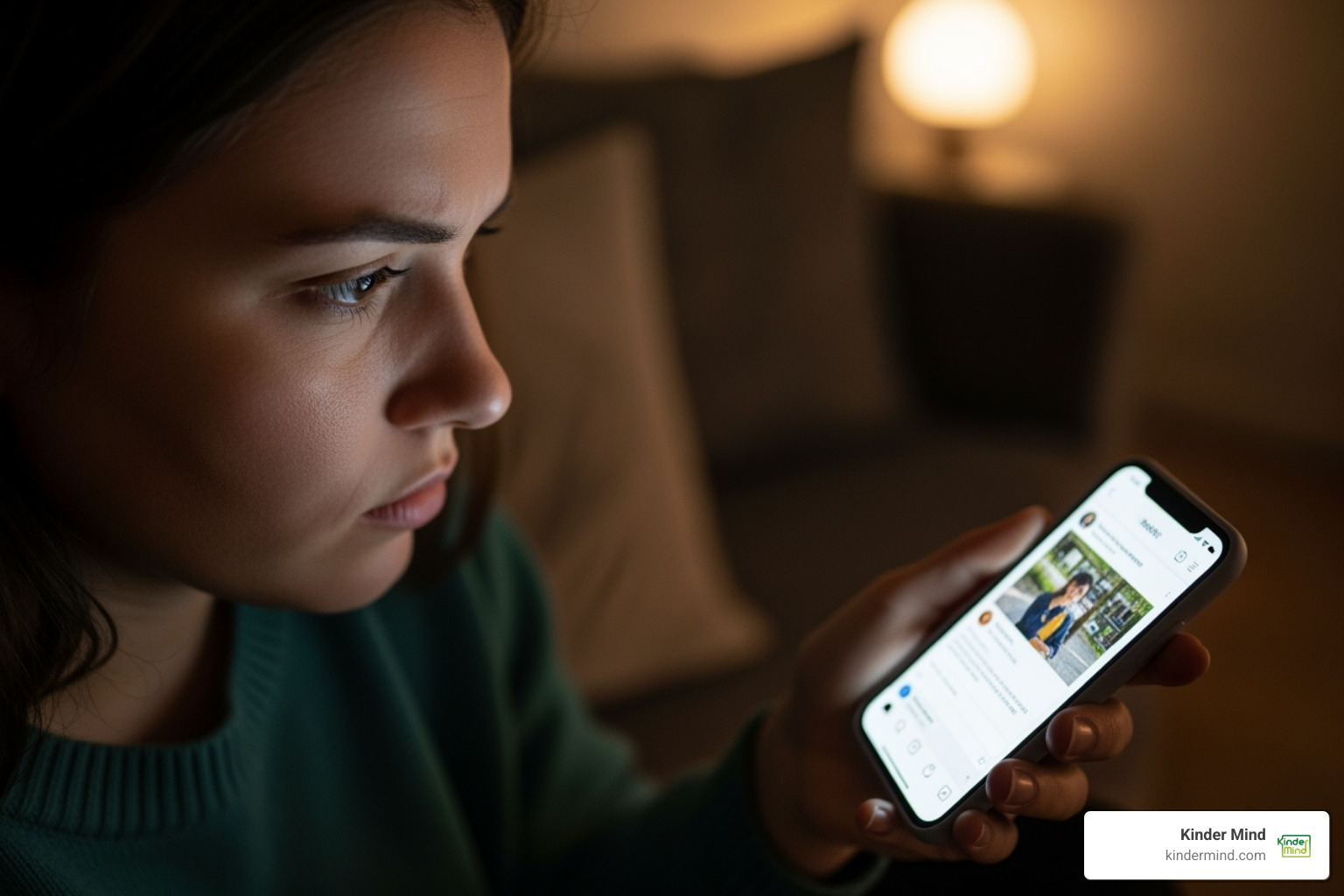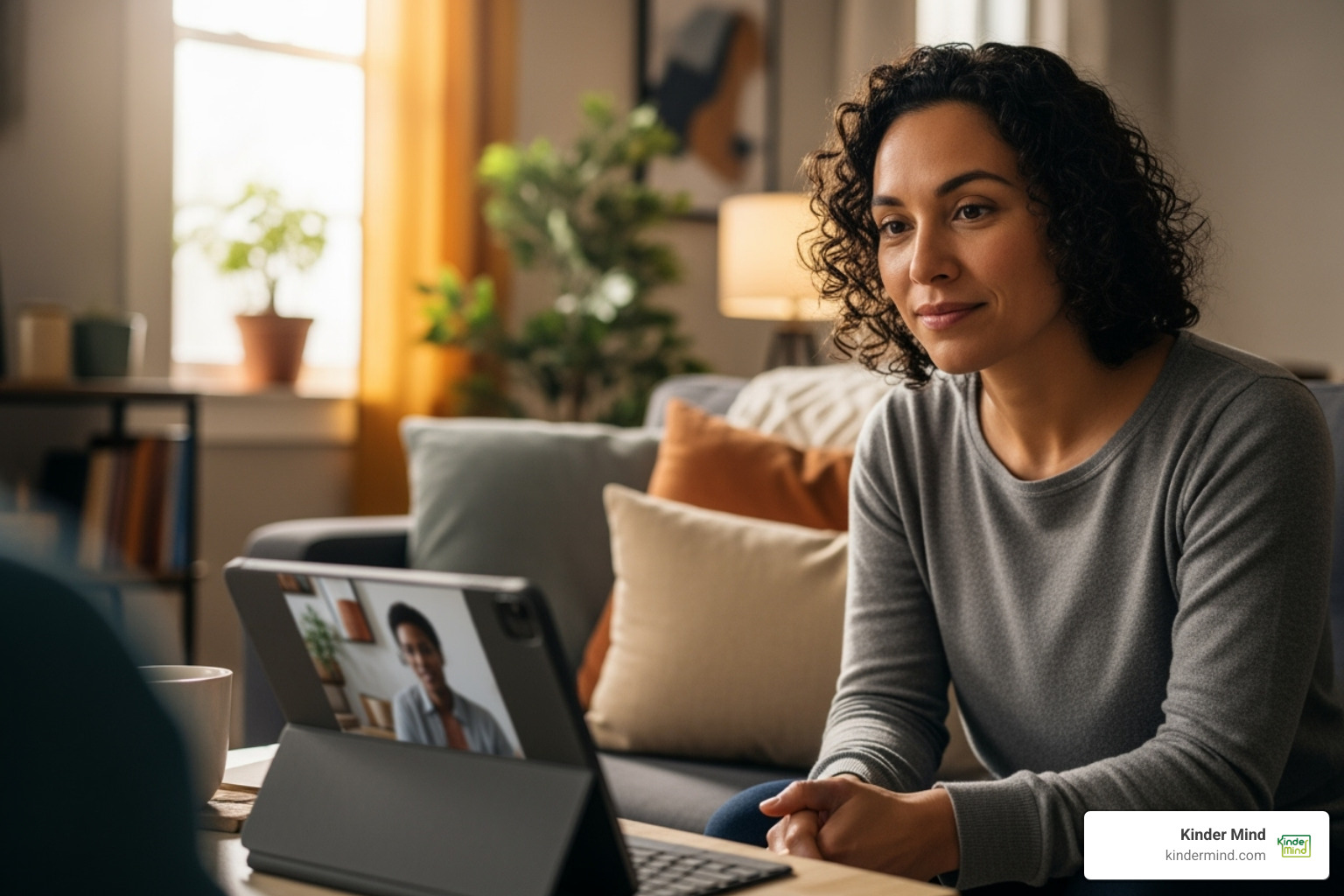Beyond the Keyboard: Navigating Social Anxiety in the Virtual World
Why Online Social Anxiety Matters Now More Than Ever
Online social anxiety is the fear and self-consciousness people experience during digital interactions, from posting on social media to joining a video call. It's the same anxiety felt in face-to-face situations, transferred to the virtual world we now spend so much time in.
Quick answers about online social anxiety:
- What it is: Intense fear of judgment, embarrassment, or negative evaluation during online interactions (social media, video calls, messaging)
- How common: Affects millions, especially among the 88% of 18-29 year-olds using social media regularly
- Key signs: Overthinking posts, avoiding video calls, excessive editing, fear of likes/comments, comparing yourself to others
- Why it happens: The same negative thought patterns from in-person anxiety transfer online, often amplified by the "culture of shares and Likes"
- Can it be helped: Yes—through CBT techniques, mindfulness, active engagement, and professional support when needed
The digital world presents a paradox. It offers control—you can edit a message or hide a blushing face—but this control can become a trap. For the many people with social anxiety, the online world isn't an escape; it's another stage for feared judgment. As research from Psyche notes, while you can curate what you share, online interactions can still feel as fraught with self-consciousness as real-life encounters.
The stakes are high. Studies show that while people with social anxiety may prefer online communication, they still experience the same negative thoughts and fear of judgment. Worse, passive online interaction and social comparison are linked to poorer wellbeing regardless of social anxiety levels.
But here's the good news: understanding how social anxiety manifests online is the first step to managing it. The cognitive patterns are predictable, the strategies are proven, and support is more accessible than ever.

The Double-Edged Sword: Benefits and Drawbacks of the Online World
For people with online social anxiety, the digital world offers both unexpected comfort and hidden challenges. Online spaces aren't simply "better" or "worse"; how you use them makes all the difference.

For example, online learning can be life-changing for students whose anxiety makes traditional classrooms overwhelming. It offers control over when and how you interact, removing many triggers while still allowing for growth. Some research suggests it can even serve as a therapeutic tool, gradually building confidence. If you're curious about how virtual settings can support mental health, you can learn more info about virtual therapy.
The Allure: Why Online Spaces Feel Safer
Many people with social anxiety gravitate toward digital communication because it offers a sense of protection that face-to-face interactions can't.
- Control over self-presentation: You can take time to craft the perfect message, editing your words without the pressure of an immediate response.
- Anonymity of physical symptoms: No one can see you blush, sweat, or shake, which can make interactions feel infinitely less stressful.
- Reduced fear of judgment: Research suggests the screen can act as a psychological buffer, making perceived criticism feel less immediate and personal.
- A bridge to connection: Online platforms help people find communities and maintain relationships that might otherwise be difficult to sustain offline.
The Pitfalls: Hidden Dangers of Digital Socializing
Those same features that feel safe can also become traps that worsen online social anxiety.
- Passive scrolling becomes a comparison game: Mindlessly scrolling through others' highlight reels is linked to higher levels of depression and anxiety. You start making upward social comparisons, assuming everyone else's life is better, which research shows can impact self-esteem.
- Your anxious beliefs get confirmed: When you're convinced people are judging you, a post with few likes or a delayed response can feel like proof, reinforcing negative beliefs.
- FOMO (fear of missing out) hits harder: Social media makes it impossible to ignore what you're missing, confirming fears that you're on the outside looking in.
- Online interaction can become problematic: When online communication becomes an avoidance strategy, it can spiral into unhealthy habits that interfere with daily life.
- It doesn't actually improve wellbeing: Research confirms that online social interaction, especially passive use, is related to poorer wellbeing. The online world might feel safer, but that doesn't mean it's helping your mental health.
Understanding this paradox is the first step toward using digital spaces in ways that support you.
Understanding the Mindset of Online Social Anxiety
Online social anxiety isn't a separate condition from real-world social anxiety. The same thought patterns and behaviors that make face-to-face interactions difficult simply follow you into the digital world. The good news is that the strategies that work offline can be adapted for your online life.

The Clark and Wells cognitive model of Social Anxiety Disorder applies just as well to Facebook posts and Zoom calls. It shows that socially anxious individuals tend to focus negatively on themselves, use protective "safety behaviors," and interpret ambiguous social cues in the worst possible light. Research confirms these same mechanisms are at play in the virtual world.
Cognitive and Behavioral Patterns in online social anxiety
When dealing with online social anxiety, you're likely caught in a cycle of specific thoughts and behaviors.
- Negative thought patterns: You assume the worst, worrying that a post will be judged or a message sounds boring. You interpret ambiguous situations negatively—a delayed reply must mean someone is angry. Research shows people with high social anxiety are far more likely to put a negative spin on interpretations of ambiguous scenarios.
- Self-focused attention: You spend more time monitoring yourself than engaging. On a video call, you might fixate on your own image, worrying about how you look instead of being present in the conversation.
- Safety behaviors: These are actions you take to prevent feared outcomes, but they stop you from learning your fears are unfounded. Online, this includes excessively editing posts, constantly checking for likes, avoiding personal content, using anonymous profiles, or over-preparing casual messages.
These patterns show that the digital world hasn't erased social anxiety; it has just given it a new stage.
How High vs. Low Social Anxiety Shapes Social Media Use
Research reveals a stark contrast in how people experience social media based on their anxiety levels.
- High Social Anxiety: Users report higher anxiety, use more safety behaviors (like excessive editing), and experience more negative thoughts ("I'm boring," "They'll judge me"). They are more likely to interpret ambiguous situations negatively. A study found 64.5% prefer online communication with acquaintances, and 29% regularly monitor their friend count, compared to just 3.7% of low-anxiety users.
- Low Social Anxiety: Users experience less anxiety, use fewer safety behaviors, and have fewer negative thoughts. They are more comfortable with face-to-face communication and less likely to interpret online situations negatively.
The paradox is that even though those with high social anxiety prefer online platforms—with 98% in one study using Facebook daily—they still experience more distress. The digital world that feels safer doesn't necessarily make them feel better. If you recognize these patterns in yourself, exploring Specialties online therapy for anxiety can provide targeted support.
Actionable Strategies for Healthier Online Interactions
Managing online social anxiety is about learning practical skills to interact with more confidence. These strategies are grounded in Cognitive Behavioural Therapy (CBT), a proven approach for changing unhelpful thought patterns and behaviors. The key is to start small and be patient with yourself.
Shift Your Focus from Self to Other
When you're anxious online, it's easy to get trapped in self-focused attention—worrying about how you appear on video or how your message sounds. The solution is to train your brain to focus outward.
A method called Attention Training Technique (ATT) can help strengthen attentional control. In practice, this means:
- During video calls, hide your self-view. This forces you to focus on the other person and the conversation, not your own image.
- Practice active listening. Concentrate on what others are saying instead of rehearsing your next line.
You can build this skill by practicing mindfulness in everyday moments, like focusing on the sounds around you or picking out instruments in a song.
Challenge Negative Thoughts and Break the Cycle
Anxious thoughts like "Everyone will think my post is stupid" are often predictions, not facts. CBT can help you break this cycle.
- Identify automatic negative thoughts. Notice what runs through your mind before you post or after you send a message.
- Question their validity. What actual evidence supports this thought? What contradicts it? Could a delayed reply be due to something other than judgment (e.g., they're busy)?
- Seek alternative explanations. Your anxiety focuses on the worst-case scenario. Practice considering other, more likely possibilities.
- Reduce avoidance. If you always avoid posting, try sharing something small. Observe what actually happens. This gathers real evidence that challenges your anxious beliefs.
If you're interested in this approach, learn more about the Best online CBT therapy for anxiety.
Engage Actively, Not Passively
Endless, passive scrolling is linked to higher levels of depression and anxiety. The antidote is to move from "lurking" to participating, even in small ways.
- Share low-stakes content. Post an interesting article or a photo of something that made you smile. The goal is participation, not perfection.
- Join communities around your interests. In a group that shares your passion, conversation flows more naturally.
- Respond to others' posts. Leave a thoughtful comment or react to a friend's share. This shifts your focus outward and creates genuine interaction.
- Set limits on scrolling time. Use your phone's timers to prevent unproductive passive consumption.
The goal is to use these platforms in ways that foster connection rather than reinforcing fear.
When and How to Seek Professional Support
While self-help strategies are beneficial, there are times when online social anxiety requires professional intervention. Knowing the signs and how to access support is a crucial step toward well-being.

Recognizing the Signs You Need Help
It's time to seek professional help when your anxiety becomes limiting. Key signs include:
- Interference with daily life: Your fear prevents you from joining work meetings, participating in online classes, or connecting with friends and family.
- Problematic internet use as avoidance: You use the internet excessively to avoid face-to-face interactions or real-world responsibilities.
- Reinforcing offline fears: Online experiences, like social comparison or negative interpretations, are making you more anxious in all social situations.
- Significant distress: You experience intense fear before posting, panic symptoms during video calls, or prolonged worry after sending a message.
For more information on recognizing these indicators, refer to Anxiety Symptoms.
How Online Therapy Can Help with online social anxiety
Online social anxiety is highly treatable, and online therapy is an effective and accessible solution. It's fitting to use a virtual platform to address anxiety that appears in virtual spaces.
- It provides a safe space to practice. Engaging with a therapist from home can feel less intimidating than an in-person visit, making it easier to open up. This can be a stepping stone to building broader social confidence. Learn more about Therapy for anxiety.
- You get expert guidance on CBT techniques. The Best online CBT therapy for anxiety is the gold standard treatment, and studies show online CBT is just as effective as in-person therapy for helping you challenge negative thoughts and behaviors.
- It facilitates gradual exposure therapy. A therapist can guide you through controlled exposures to feared online situations, helping you build confidence at a manageable pace.
- It removes barriers to care. Online therapy eliminates geographical constraints and travel time, making it easier to find a specialist and fit sessions into your life. For a guide to teletherapy, see Navigating wellness: Your guide to teletherapy mental health services.
Kinder Mind offers accessible, in-person and virtual mental health therapy services. With affordable care options, including insurance and reduced-rate plans, we aim to increase access to care across many states. Seeking help is a sign of courage, and with the effectiveness of Online therapy for anxiety, managing your symptoms is more achievable than ever.
Frequently Asked Questions about Online Social Anxiety
Can online interactions make social anxiety worse?
Yes, it can. When you passively scroll and compare yourself to others' highlight reels, it can worsen feelings of inadequacy. Using online communication to completely avoid face-to-face interactions also prevents you from building real-world coping skills, which can intensify overall anxiety. However, when used mindfully for active engagement and genuine connection, online platforms can be a tool for building confidence.
Is avoiding social media a good strategy for social anxiety?
While taking a break can be healthy, completely avoiding social media isn't a practical long-term solution. So much of our social and professional lives happen online, and total avoidance can lead to isolation and reinforce your fears. A more effective approach is to learn how to use these platforms in a way that feels less stressful, such as setting time limits and engaging more actively.
How is online social anxiety different from just being shy?
Shyness is a personality trait involving temporary discomfort in new social situations. It doesn't typically interfere with your daily life. Online social anxiety, on the other hand, is a more intense and persistent fear of being judged or humiliated, both online and off. This fear can cause significant distress and impairment in relationships, work, and school. While a shy person might feel awkward, someone with social anxiety experiences a level of distress that often requires support to manage.
Conclusion: Find Your Balance in the Digital World
The digital world is a permanent fixture in our lives. For those with online social anxiety, the goal isn't to disconnect entirely, but to learn how to engage in a healthier way. By understanding the thought patterns and behaviors that fuel your anxiety, you can start applying practical, CBT-based strategies—like shifting your focus, challenging negative thoughts, and engaging actively—to regain control.
The online world is a tool, and its impact depends on how you use it. With the right approach, you can transform digital interactions from sources of stress into opportunities for genuine connection.
If online social anxiety is interfering with your daily life, professional support can make a significant difference. Kinder Mind offers accessible and affordable mental health therapy, both virtually and in-person. Our therapists specialize in anxiety and can provide you with proven techniques to help you build confidence. Find a therapist to help you navigate social anxiety and start your journey toward feeling more at ease, online and off.
We believe cost shouldn't be a barrier, which is why we work with many insurance providers. Learn more about Online therapy that takes insurance.
You deserve to find your balance and engage with the world with confidence and peace of mind.


